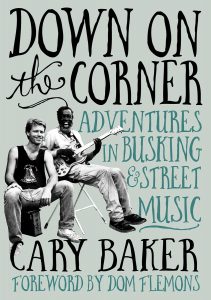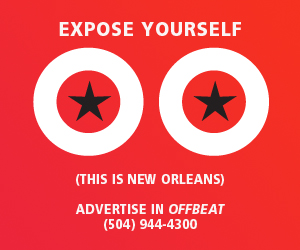The very idea of street busking is one of the most romantic images in popular music, whether you’re thinking of the blues in Chicago, rock ’n’ roll taking shape under streetlights in New York, or whoever’s playing for tourists on Royal Street at this very moment. Veteran journalist Cary Baker takes an overdue look at the phenomenon in this book and in doing so, he creates a workable alternative history of popular music—where the street players are the heartbeat that powers it all.
Baker is known as a publicist whose career goes back to working with R.E.M. in their heyday. But he’s first and foremost a blues scholar, and some of his liner notes are probably in your collection if you have a proper one. So, he rightly puts the blues at the forefront of his story, opening with a history of Maxwell Street in Chicago, which remained an under-the-radar blues hotbed well into the ’80s. But the book goes on to study a wide variety of artists in other genres and argues for their influence on bigger-named artists.
You may remember, for example, that a Greenwich Village street character named David Peel made a 1968 album called Have a Marijuana, which was a college-dorm staple in that era, in part because the word “fuck” was on it. But you probably didn’t know that one of the NYC street kids who was seen singing along with every word, was Joey Ramone (John Lennon also admired Peel enough to produce a later album). Likewise, the Reverend Pearly Brown, a Macon, Georgia slide guitarist who played the streets, was an influence on both the Allman Brothers Band and Lucinda Williams. (He also was in a Wet Willie album cover, and the band was sued for its troubles. He also untangles the story of Moondog, a visionary who might have been a renowned composer if he had any desire to be one (Charlie Parker and Philip Glass both did their best to convince him otherwise).
You may wonder what Elvis Costello is doing here, but it’s recounted that he owes his U.S. record contract to his setting up outside a CBS convention—not that he got signed on the spot (he was in fact arrested) but because he prompted one A&R exec to seek down an import record on his afterwards. And with my own Boston roots I’m glad to see a chapter devoted to Mary Lou Lord, who did the near-impossible by getting random subway passengers to hear and appreciate Richard Thompson songs.
New Orleans of course figures prominently into the story, and he traces the city’s busking tradition back to the 1830’s, when a figure known as Old Corn Meal would break into song when not selling the stuff; Louis Armstrong apparently owes his famous nickname to playing the streets (He became Satchel Mouth after stuffing tips into his cheeks). History is raced through key figures like Snooks Eaglin, Little Freddie King and David & Roselyn, to modern figures like Meschiya Lake and Tuba Skinny, who provide insight on their inspirations (this magazine, OffBeat, is referenced a few times).
It’s nearly impossible to read this book without discovering some musical legend you’d never heard of, so it could set you up for a deeper dive. Just as likely, it might send you out to the streets to see what happens next.




